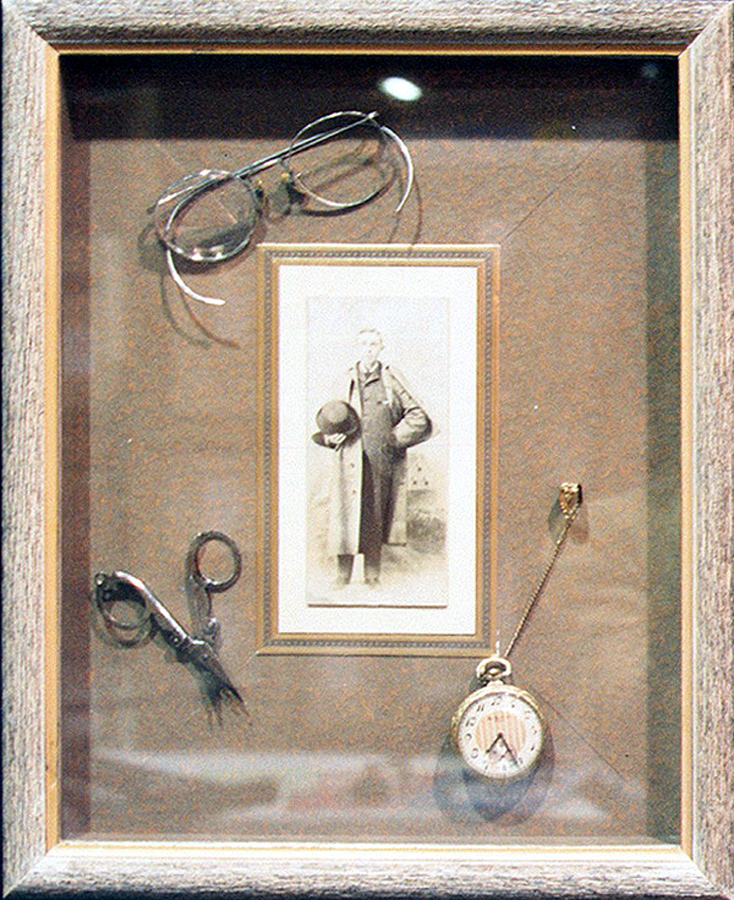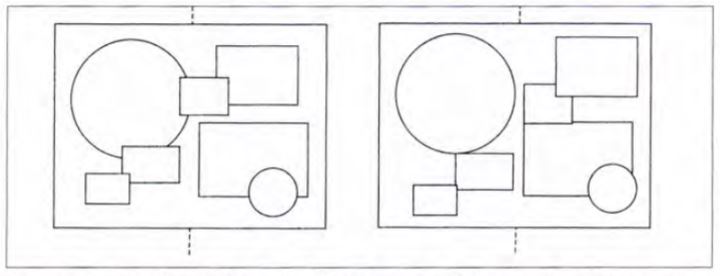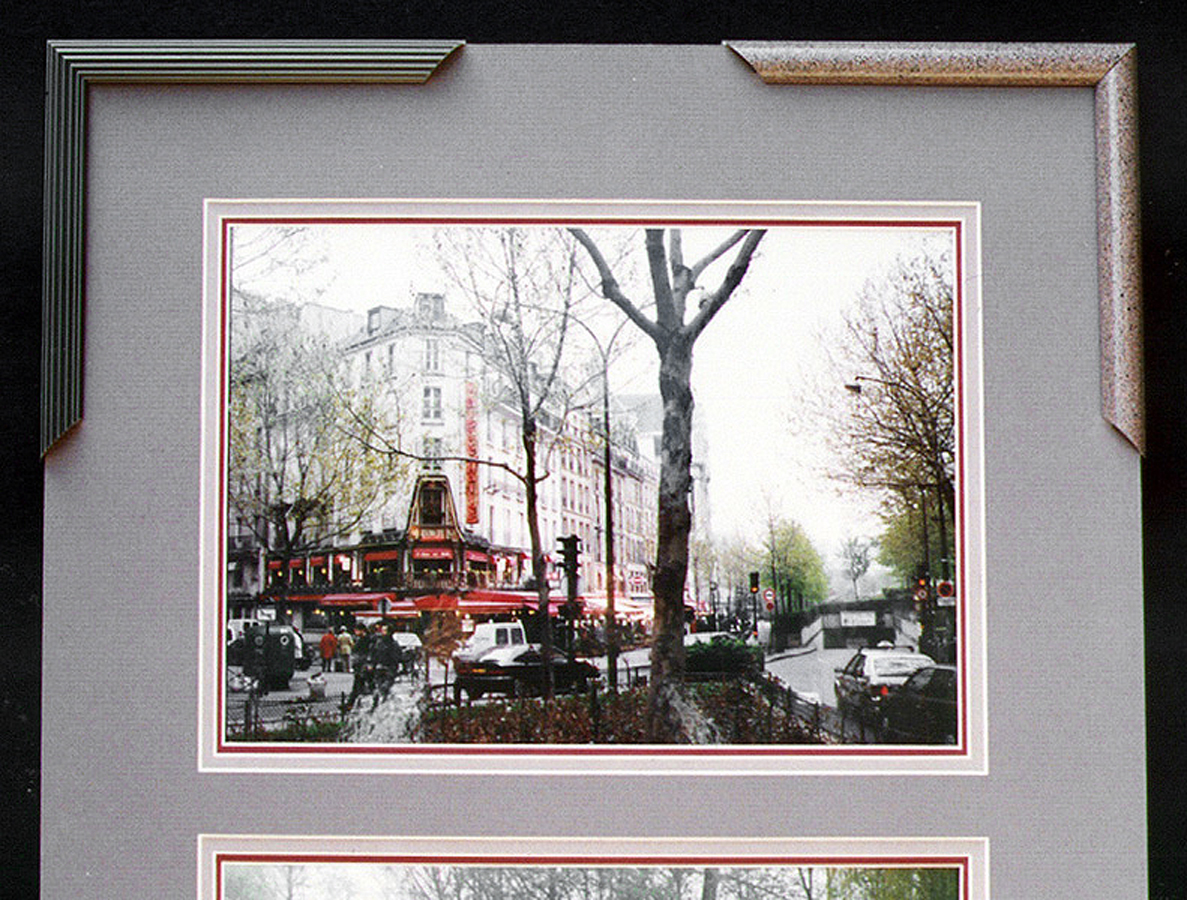 Photo 1
Photo 1
Though all the items are different in color, shape and texture, a unity of theme as well as unity through variety have been achieved. Photo courtesy of Larson-Juhl, design by Greg Perkins, CPF.
The selection and arrangement of the formal principles in a work of art or framing is design. Line, texture, color, shape, intensity, space and rhythm are all easily identifiable elements, while proportion, balance and emphasis may be tougher to pinpoint, but complete the package. The ultimate pulling together of a work of art or framing design using the tools of these principles creates a quality of oneness, known as unity. It is perhaps the closest thing to a rule that exists in both fine art and all aspects of design. Unity implies that a congruity or fusion exists among the individual elements and they are in harmony as a result of careful and deliberate planning.
Unity defines as "...making into or becoming a single unit". The various individual elements in a design must all appear intentional and interrelated or the basic design will fall apart. A viewer will always subconsciously look for organization within a design, something that feels comforting and familiar. So when there is a sense of coherent unity it will naturally also be a successful design.
Review of Principles
The elements of line, color, texture, shape, intensity, and space are all the ingredients or building blocks with which the artist or designer works. The factors of proportion, balance, emphasis rhythm and unity are the recipe or directions for assembling them into an aesthetic and successful design. Together the elements and factors form the principles of the design process, and together they will either unite any given design or allow it to feel weak or to fall apart.
It is important to understand the integration of the first group of elements in order to grasp the second group of factors. It is easier to identify the elements than the factors. The elements of any design are the materials of the designer; the factors establish the methods by which these materials are set into motion or are used. Just as it is true that shape and space flow in and out of each other, that texture can be the result of highlights and shadows of line and color, all the principles work together for a unified whole. If they are isolated then one may dominate the other and the design may be lost.
Visual vs. Intellectual Unity
One's initial response to a successful frame design is a feeling of visual unity in that the whole dominates over the individual parts. Each selected element (line, color, texture...) has a meaning and impacts the total presentation. Visual unity denotes a harmony or oneness between the chosen elements that is apparent to the eye. No one thing stands alone or demands visual attention.
Intellectual unity illustrates a common theme or central idea. An object box showcasing Great Grandmother's handkerchief, purse, and photograph represent this concept of common theme in an attempt at unity (photo 1). Unity is the quality of oneness that is almost unavoidable when something develops out of a strong, clear purpose or idea, like Grandmother's keepsakes. A unified theme, however, does not necessarily produce a unified design. Thus, visual unity and intellectual unity are two separate and individual issues which must not be confused and should always be considered.
 Photo 1
Photo 1
Though all the items are different in color, shape and texture, a unity of theme as well as unity through variety have been achieved. Photo courtesy of Larson-Juhl, design by Greg Perkins, CPF.
Use of a common theme, especially in memorabilia boxes, is a strong basis for good frame design. Though a great starting point, it is essential that the chosen elements from line, color, texture, shape, intensity and space be controlled, organized and integrated in order to establish the desired visual unity. This is managed and manipulated through the binding qualities of the remaining principles of organization (rhythm, proportion, balance and emphasis).
Four Ways to Achieve Unity
Limited Elements
Though unity may be achieved in many ways, there are four basic concepts which remain the easiest to help integrate unity into a successful design. First, limit the number of elements used in a framing design from three to five (see February 2000). Reinforcing design concentration by integrating only a few specific principles ensures some degree of oneness, for there is less to distract the viewer from the basic concept. It is a matter of 'less is more' as seen in many award winning designs.
Proximity and Strong Boundaries
The second is through proximity. Frames around paintings and fences around gardens are great examples of proximity through strong enclosure. The frame surrounds the collectibles into a unit while setting them apart from the rest of the room. But it's not enough to merely have Grandpa's personal possessions randomly scattered within a frame, they must somehow relate to each other (photo 2). Compare the overlapping of Great Grandmother's objects to that of the more scattered look of Grandpa's. Establishing visual unity by manipulating the elements of space, placement and emphasis to create a visual flow as they are placed within the design is necessary (diagram 1).
 Photo 2
Photo 2
But it's not enough to merely have Grandpa's personal possessions randomly scattered within a frame. Compare the overlapping of objects in photo 1 to the more scattered look of Grandpa's keepsakes. Sample courtesy of Crescent Cardboard.
 Diagram 1
Diagram 1
Unity through Proximity—There is more to balance and unity than just even weight on either side of an imaginary central point. Overlapping the images in a shadow box will integrate them and allow for visual control or emphasis. Controlling the movement and flow of the viewer's eye is a major part of successful design. On the other hand, static placement where objects barely touch or align without interaction makes the design appear dull and lifeless. This eliminates unity and, in turn, viewer interest.
Repetition of Patterns
The third way to develop the feeling of unity is through repetition (textures, patterns, shapes), also known as rhythm. Remember once the use of an element has been established, reusing it still only counts as one element (in the three to five limitation). A similarity in size (multiple openings cut the same dimensions), shape (echoing the round or oval in a pair of glasses), or color (picking up the sepia tones in an aged photo) will definitely help tie things together.
Rhythm/repetition can produce both variety and unity. Emphasis, balance and rhythm all work together towards unifying a good framing design. The unity created through repetition of a button framed alongside an identical button may be good, but is not nearly as interesting as unity created through the contrasting variety of a button framed with a buttonhole. Thus, mirror images may be slightly too academic to be visually stimulating and perhaps border on repetitious monotony, they are too literal.
Harmony of the Parts
Establishing harmony of the parts is the fourth unifying method. The design components should all share something in common. Design harmony may be achieved by tailoring use of the chosen elements to reflect specific categories such as a particular type of art (botanical, art Deco, Impressionist...), or historical period (Elizabethan, Louis XIV...), this is also called style. Moulding styles readily reinforce establishment of a mood, color, and often specific period of any given design. This establishes both visual and intellectual unity through a consistency of period, style and ultimately creates harmony.
Unity and Variety
Variety is the counterpart to unity. Too much unity through consistency and similarity may be deadening or boring, like the two identical buttons. Adversely, if variety gets out of control through too much contrast, unity also suffers. If repeating specifically chosen colors, textures and shapes helps establish unity (photo 3), then modifying or isolating those same elements might create more variety through contrast. Use of contrast should be tasteful and subtle, yet make a noticeable (not jarring) statement.
 Photo 3
Photo 3
Visual unity is achieved through repetition and rhythm by reintroducing the blue and white diamonds from the artwork into the lower mat border. Artwork courtesy of Larson-Juhl.
Unity in photo 3 is attempted by reintroducing the elements of color and shape through the blue and white diamonds in the lower mat border. The rust colored background in the lower ⅓rd of the artwork is also echoed. The diamonds were minimized by repeating only four on either side maintaining isolated or limited contrast. It would have been more dominant if the shapes had been placed at the lower left corner running from the draped blanket onto the mat. Either solution represents an integration and use of visual unity through color, shape and in the second concept perhaps placement or emphasis.
Developing Variety
Variety, contrast, and in turn unity can be achieved by expanding on the base idea. When a customer brings in a photograph of your Great Grandmother to have framed for the family wall, suggest she also bring in a few additional personal items of Grandmother's, like her handkerchief, clutch purse, broach, necklace or personal letter (photo 1). Though all the items will be different in color, shape and texture, it still creates a unity of theme as well as unity through variety.
Unity and variety are fundamental in art and framing. A pair of opposites both complement and supplement each other. Unity leads to order, while variety brings vitality through contrast. They interact and balance each other so that an active oneness dominates over monotony or chaos. If variety gets too extreme and out of control (painted bevels, glass etching, embossing, decorative cutouts), unity will be lost, but too much consistency is also killing. Some of the best designs have united many variables into a cohesive and pleasing entity between art and framing.
No single frame design is THE perfect solution to a problem, it is only ONE solution. This is evidenced by the myriad of design presentations at any PPFA National Print Competition. One print, one theme, fifty variations as a solution. Though all are regional winners already, some are successfully unified while others attempt to showcase too many design ideas. Again, less is more.
Unity Through Color
Color probably has the most variation when it comes to using it for unity, because of the endless opportunities for color relationships. There are two basic ways of organizing colors for unity. Unity through color hues would target analogous colors or any two colors adjacent to a key color on a color wheel. They perhaps reflect an ink color from the art in a surface mat or panel design (photo 4). Unity through color contrast, or those directly opposite on wheel, might utilize complementary colors in a liner mat or painted bevel.
 Photo 4
Photo 4
Unity through the use of warm analogous colors enhances this French photo. The moulding options will either pull colors from the tree bark and dark windows or will harmonize with the middle mat and texture of the sunless afternoon haze.
Unity through color was attempted by selecting analogous colors from within the photo for the surface and middle liner mats. The red ⅛" bottom liner is both a direct color echo from the trim on the French store front and a complimentary color to the green foliage surrounding it. It also unifies the design by using analogous, warm colors in all of the mats selected. If the same triple mat of ⅛", ¼" and 2" used all mauve mats, it would lose the variety and visual interest by establishing a monotony. Though all the colors would be represented within the photo, and in unified harmony, it would show no interesting contrasts.
Design Integrity
The quality that makes a design a unique expression of its time and creator is integrity, a quality or state of being whole. Unity in an artist's conception is what makes it personal and original. Unity in a frame design includes everything from using appropriate materials, as in conservation framing, to the interpretive way in which a framing layout is presented.
Fundamental Unity
Unity in art and framing results from practicing, knowing, and selecting the right visual devices (elements) and using the best fundamentals (factors) to relate them to each other. By studying the principles of form and design, the beginning designer will gain an understanding that will later help with successful intuitive and creative expressions of framing design.
The elements of line, color, texture, space, intensity, shape, and rhythm cannot exist exclusively on their own. They are impacted by the technical use of the factors of proportion, balance and emphasis. Together there is a constant overlapping of them as they borrow and impact each other to become more visible or expressive. Unity remains the whole or total effect of a frame design which results from the combination of all its component parts. It is achieved by opposing forces brought into harmony by the means of transition and flow as interdependent components of the total composition.
This is not to say that all principles will always be present in every design. It is possible for a framing design to be devoid of variations, of multiple colors, or more than one texture. They form the body from which the designer can choose, the tools to create a successful unified design. The one principle that is essential to every work of art or framing design is the principle of unity. No design will every be truly successful without the sense of unity that relates the parts and harmonizes all its elements into a total composition.
Design with Pride
For the past two years, every other month, I have discussed the essence of framing design from the basics of traditional and formal fine art design theories. Each month targeted a specific principle with examples and discussion of its use in framing. The principles remain the same whether for painting, sculpture, or picture framing but practical use and integration do somewhat vary. Once the concepts have been understood then award winning unified framing designs are simply a matter of execution. There is no excuse but to create only wonderful, unified, well designed pieces. With a better understanding of unity and contrast, collaborating the other elements and factors into the perfect design for any customer or framing competition is easy. The principles of framing design are fundamental for successful and consistent creations.
END
Copyright © 2001 Chris A Paschke
For more articles on mounting basics look under the mounting section in Articles by Subject.
Additional information on all types of mounting is found in:
The Mounting and Laminating Handbook, Second Edition, 2002,
The Mounting And Laminating Handbook, Third Edition, 2008 and
Creative Mounting, Wrapping, And Laminating, 2000 will teach you everything you need to know about getting the most from your dry mount equipment and materials as an innovative frame designer.
All books are available from Designs Ink Publishing through this website.
Chris A Paschke, CPF GCF
Designs Ink
Designs Ink Publishing
785 Tucker Road, Suite G-183
Tehachapi, CA 93561
P 661-821-2188
chris@designsinkart.com
